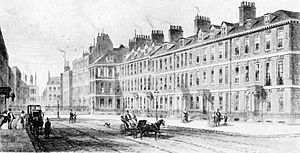Statue of Queen Anne, Queen Anne's Gate facts for kids
Quick facts for kids Queen Anne |
|
|---|---|
 |
|
| Artist | Unknown |
| Year | c. 1705 |
| Type | Statue |
| Medium | Portland stone |
| Subject | Anne, Queen of Great Britain |
| Dimensions | 210 cm (83 in) |
| Location | Queen Anne's Gate, London SW1, United Kingdom |
|
Listed Building – Grade I
|
|
| Official name | Statue of Queen Anne against north flank of No 15 Queen Anne's Gate |
| Designated | 5 February 1970 |
| Reference no. | 1227294 |
A special statue of Queen Anne stands proudly in Westminster, London. It is located next to a building at No. 15 Queen Anne's Gate. This statue is considered very important, which is why it's called a "Grade I-listed" artwork. This means it's one of the most important historic buildings or structures in England.
The statue shows Queen Anne wearing a fancy skirt and top, with a long cloak. On her cloak, you can see the special symbol of the Order of the Garter, a very old and important group of knights. She wears a small crown on her head and holds an orb (a ball with a cross, symbolizing power) and a sceptre (a royal staff).
The statue is made from a type of stone called Portland stone. It stands on a base made of the same stone. On the base, it says ANNA REGINA, which means "Queen Anne" in Latin. We don't know for sure who carved this statue or exactly when it was made, but experts believe it was created in the early 1700s.
Contents
The Statue's Journey Through Time
How Queen Anne's Gate Began
The area where the statue stands, called Queen Anne's Gate, was built around 1704-1705. A banker named William Paterson developed it. Back then, it wasn't one long street. It was two separate areas, divided by a wall with two openings. One side was Queen Square, and the other was Park Street.
Where the Statue First Stood
The statue of Queen Anne was first mentioned in a book from 1708. It said the statue was "erected in full proportion on a pedestal" at the east end of Queen Square. A map from 1710 shows the statue right in the middle of the dividing wall, with gateways on either side.
Moving to a New Spot
Sometime in the early 1800s, the statue was moved. In 1814, a magazine called Gentleman's Magazine reported that the statue, which used to be in a clear spot, was now "huddled up in a corner."
When the Statue Needed Repairs
By 1862, the statue was in bad shape. It had lost its nose and its right arm! The Earl of Caernarvon and other people living nearby were unhappy about this. They wrote to the government office in charge of public works, asking them to fix it.
The First Commissioner of Works, William Cowper, agreed to help. Even though he didn't think the statue was a great piece of art, he felt it was important to fix it. He believed a statue of a queen shouldn't be left in public without a nose or an arm.
How the Statue Was Fixed
A sculptor named John Thomas was hired to repair the statue. To make sure the queen's face looked right, he used a plaster cast (a "squeeze") from another statue of Queen Anne. This other statue was made by Francis Bird and stands outside St Paul's Cathedral.
John Thomas replaced the missing right arm with a new one made of marble. He also added a new bronze sceptre for the queen to hold.
Why Kids Damaged the Statue
The statue was damaged partly because local children had a mistaken idea. They thought the statue was of Queen Mary, who was sometimes called "Bloody Queen Mary." The children would ask the statue to come down. When it didn't, they would throw things at it!
To stop this, William Cowper suggested in 1862 that the name "Queen Anne" be clearly written on the base. John Thomas added this inscription during his repair work. Even so, the damage continued for a while before it finally stopped.
A Fun Legend About the Statue
There's also a fun legend about the statue. People say that on August 1st, the day Queen Anne died, the statue climbs down from its base. Then, it walks three times up and down the street!
Moving to Its Current Spot
In 1873, the wall that divided the two streets was taken down. This created the Queen Anne's Square we see today. At that time, the statue was moved to where it stands now.
Who Owns and Cares for the Statue?
For a long time, there was a disagreement about who owned the statue. It wasn't officially taken care of by the government when a law about public statues was passed in 1854. The owner of the house at 15 Queen Anne's Gate allowed repairs in 1862 but didn't want to give up ownership.
In 1938, the house owner, E. Thornton Smith, paid for more repairs himself. He found a way to make sure the statue would be cared for in the future. He was the Master of the Worshipful Company of Gardeners, a historic group. He gave the statue to them, and they agreed to pay for future repairs. The Office of Works would do the actual repair work.
Protecting the Statue During Wartime
During the Second World War, in 1940, a thick brick wall was built around the statue. This was done to protect it from bombs. The wall stayed there until April 1947, when it was finally removed.


